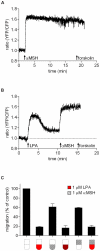LPA is a chemorepellent for B16 melanoma cells: action through the cAMP-elevating LPA5 receptor
- PMID: 22195035
- PMCID: PMC3237609
- DOI: 10.1371/journal.pone.0029260
LPA is a chemorepellent for B16 melanoma cells: action through the cAMP-elevating LPA5 receptor
Abstract
Lysophosphatidic acid (LPA), a lipid mediator enriched in serum, stimulates cell migration, proliferation and other functions in many cell types. LPA acts on six known G protein-coupled receptors, termed LPA(1-6), showing both overlapping and distinct signaling properties. Here we show that, unexpectedly, LPA and serum almost completely inhibit the transwell migration of B16 melanoma cells, with alkyl-LPA(18:1) being 10-fold more potent than acyl-LPA(18:1). The anti-migratory response to LPA is highly polarized and dependent on protein kinase A (PKA) but not Rho kinase activity; it is associated with a rapid increase in intracellular cAMP levels and PIP3 depletion from the plasma membrane. B16 cells express LPA(2), LPA(5) and LPA(6) receptors. We show that LPA-induced chemorepulsion is mediated specifically by the alkyl-LPA-preferring LPA(5) receptor (GPR92), which raises intracellular cAMP via a noncanonical pathway. Our results define LPA(5) as an anti-migratory receptor and they implicate the cAMP-PKA pathway, along with reduced PIP3 signaling, as an effector of chemorepulsion in B16 melanoma cells.
Conflict of interest statement
Figures








Similar articles
-
Protein kinase A inhibits lysophosphatidic acid induction of serum response factor via alterations in the actin cytoskeleton.Cell Signal. 2004 Oct;16(10):1141-51. doi: 10.1016/j.cellsig.2004.03.006. Cell Signal. 2004. PMID: 15240009
-
GPR92 as a new G12/13- and Gq-coupled lysophosphatidic acid receptor that increases cAMP, LPA5.J Biol Chem. 2006 Aug 18;281(33):23589-97. doi: 10.1074/jbc.M603670200. Epub 2006 Jun 14. J Biol Chem. 2006. PMID: 16774927
-
Linking αMSH with PPARγ in B16-F10 melanoma.Pigment Cell Melanoma Res. 2013 Jan;26(1):113-27. doi: 10.1111/j.1755-148X.2012.01042.x. Epub 2012 Sep 12. Pigment Cell Melanoma Res. 2013. PMID: 22863076
-
Autotaxin and LPA receptor signaling in cancer.Cancer Metastasis Rev. 2011 Dec;30(3-4):557-65. doi: 10.1007/s10555-011-9319-7. Cancer Metastasis Rev. 2011. PMID: 22002750 Review.
-
Ras-MAP kinase signaling by lysophosphatidic acid and other G protein-coupled receptor agonists.Oncogene. 2001 Mar 26;20(13):1540-6. doi: 10.1038/sj.onc.1204187. Oncogene. 2001. PMID: 11313900 Review.
Cited by
-
Flat clathrin lattices are dynamic actin-controlled hubs for clathrin-mediated endocytosis and signalling of specific receptors.Nat Commun. 2017 Jul 13;8:16068. doi: 10.1038/ncomms16068. Nat Commun. 2017. PMID: 28703125 Free PMC article.
-
Melanoma cells break down LPA to establish local gradients that drive chemotactic dispersal.PLoS Biol. 2014 Oct 14;12(10):e1001966. doi: 10.1371/journal.pbio.1001966. eCollection 2014 Oct. PLoS Biol. 2014. PMID: 25313567 Free PMC article.
-
Uncovering unique roles of LPA receptors in the tumor microenvironment.Receptors Clin Investig. 2015;2(1):e440. doi: 10.14800/rci.440. Receptors Clin Investig. 2015. PMID: 26005700 Free PMC article.
-
Molecular mechanisms of target recognition by lipid GPCRs: relevance for cancer.Oncogene. 2016 Aug 4;35(31):4021-35. doi: 10.1038/onc.2015.467. Epub 2015 Dec 7. Oncogene. 2016. PMID: 26640151 Review.
-
Regulation of tumor cell - Microenvironment interaction by the autotaxin-lysophosphatidic acid receptor axis.Adv Biol Regul. 2019 Jan;71:183-193. doi: 10.1016/j.jbior.2018.09.008. Epub 2018 Sep 16. Adv Biol Regul. 2019. PMID: 30243984 Free PMC article. Review.
References
-
- Choi JW, Herr DR, Noguchi K, Yung YC, Lee CW, et al. LPA receptors: subtypes and biological actions. Annu Rev Pharmacol Toxicol. 2010;50:157–186. - PubMed
-
- van Meeteren LA, Moolenaar WH. Regulation and biological activities of the autotaxin-LPA axis. Prog Lipid Res. 2007;46:145–160. - PubMed
-
- Aoki J, Inoue A, Okudaira S. Two pathways for lysophosphatidic acid production. Biochim Biophys Acta. 2008;1781:513–518. - PubMed
Publication types
MeSH terms
Substances
LinkOut - more resources
Full Text Sources
Molecular Biology Databases
Miscellaneous

